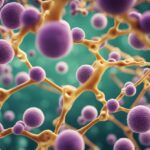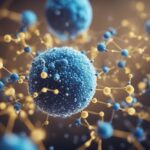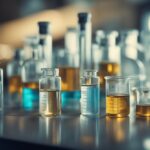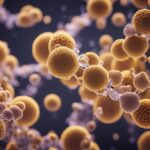As people age, their skin undergoes a natural aging process that leads to wrinkles, sagging, and other signs of aging. While it’s impossible to stop the aging process altogether, there are steps people can take to minimize the visible signs of aging and keep their skin looking youthful for as long as possible. This is where anti-aging skincare comes in.
Anti-aging skincare involves a range of products and practices designed to help reduce the visible signs of aging on the skin. This can include everything from daily skincare routines to professional treatments and lifestyle changes. By taking a proactive approach to anti-aging skincare, people can help keep their skin looking healthy and youthful for years to come.
Key Takeaways
- Anti-aging skincare involves a range of products and practices to minimize the visible signs of aging on the skin.
- Essential components of an anti-aging skincare routine include daily cleansing, moisturizing, and sun protection.
- Professional treatments and lifestyle changes can also help reduce the signs of aging on the skin.
Understanding the Aging Process
As people age, their skin undergoes a number of changes that can lead to wrinkles, fine lines, and other signs of aging. Understanding the aging process can help individuals take steps to prevent or reduce these changes.
Biological Factors of Skin Aging
The aging process is influenced by a number of biological factors, including genetics, hormones, and metabolism. As people age, their skin becomes thinner and less elastic, which can lead to the formation of wrinkles and fine lines. Additionally, the production of collagen and elastin, two proteins that help keep skin firm and supple, decreases over time.
Hormonal changes can also contribute to skin aging. For example, women may experience a decrease in estrogen levels during menopause, which can lead to a loss of skin elasticity and firmness. Additionally, changes in metabolism can affect the skin’s ability to repair itself and produce new cells.
Environmental Influences on Skin Aging
In addition to biological factors, environmental influences can also contribute to skin aging. Exposure to ultraviolet (UV) radiation from the sun is one of the primary causes of skin aging. UV radiation can damage the skin’s DNA, leading to the formation of wrinkles, age spots, and other signs of aging.
Other environmental factors that can contribute to skin aging include pollution, smoking, and poor nutrition. Exposure to these factors can lead to the breakdown of collagen and elastin, as well as damage to the skin’s cells.
To minimize the effects of environmental influences on skin aging, individuals can take steps to protect their skin. This may include wearing sunscreen, avoiding smoking and exposure to pollution, and eating a healthy, balanced diet. Additionally, using skincare products that contain antioxidants and other anti-aging ingredients can help to reduce the appearance of wrinkles and fine lines.
Essential Skincare Routine

Taking care of your skin is essential to maintain a youthful and healthy appearance. A good skincare routine can help prevent and reduce the signs of aging, such as fine lines, wrinkles, and age spots. Here are some essential skincare steps to incorporate into your daily routine:
Daily Cleansing
Cleansing is a crucial step in any skincare routine, as it helps remove dirt, oil, and impurities from the skin. It is recommended to cleanse the face twice a day, in the morning and before bed.
When choosing a cleanser, look for one that is gentle and suitable for your skin type. Foaming cleansers are ideal for oily skin, while cream or lotion cleansers are better for dry skin. Apply the cleanser to damp skin and massage gently in circular motions, then rinse with lukewarm water and pat dry.
Moisturizing Techniques
Moisturizing is another essential step in any skincare routine, as it helps keep the skin hydrated and plump. It is recommended to moisturize the face twice a day, after cleansing in the morning and before bed.
When choosing a moisturizer, look for one that is suitable for your skin type and contains ingredients such as hyaluronic acid, glycerin, or ceramides. Apply the moisturizer to the face and neck in gentle upward motions, and allow it to absorb into the skin.
Sun Protection Strategies
Sun protection is crucial to prevent premature aging and reduce the risk of skin cancer. It is recommended to use a broad-spectrum sunscreen with at least SPF 30 every day, even on cloudy days.
Apply sunscreen to the face and neck at least 15 minutes before sun exposure, and reapply every two hours or after swimming or sweating. Wearing a wide-brimmed hat and sunglasses can also help protect the skin from harmful UV rays.
Incorporating these essential skincare steps into your daily routine can help keep your skin looking youthful and healthy. Remember to choose products that are suitable for your skin type and avoid harsh ingredients that can cause irritation or damage to the skin.
Anti-Aging Skincare Ingredients
Retinoids
Retinoids are a class of vitamin A derivatives that have been shown to improve the appearance of fine lines, wrinkles, and age spots. They work by increasing cell turnover, which helps to stimulate collagen production and improve skin texture. Retinoids can be found in over-the-counter products, such as retinol, or in prescription-strength formulations, such as tretinoin.
Antioxidants
Antioxidants, such as vitamin C and E, can help to protect the skin from free radical damage, which can lead to premature aging. They work by neutralizing free radicals and preventing them from causing damage to the skin. Antioxidants can be found in a variety of skincare products, including serums, moisturizers, and sunscreens.
Peptides
Peptides are short chains of amino acids that can help to stimulate collagen production and improve skin elasticity. They work by signaling to the skin to produce more collagen, which can help to reduce the appearance of fine lines and wrinkles. Peptides can be found in a variety of skincare products, including serums and moisturizers.
Hyaluronic Acid
Hyaluronic acid is a naturally occurring substance in the skin that helps to hydrate and plump the skin. As we age, the amount of hyaluronic acid in the skin decreases, which can lead to dryness and the appearance of fine lines and wrinkles. Hyaluronic acid can be found in a variety of skincare products, including serums and moisturizers. It works by attracting and retaining moisture in the skin, which can help to improve skin texture and reduce the appearance of fine lines and wrinkles.
Professional Treatments

Professional treatments can be an effective way to combat the signs of aging. These treatments are typically performed by licensed professionals and can provide more dramatic results than at-home treatments. Here are some popular professional treatments for anti-aging:
Chemical Peels
Chemical peels involve the application of a chemical solution to the skin, which causes the top layer of skin to peel off. This can help to reduce the appearance of fine lines, wrinkles, and age spots. There are different types of chemical peels available, ranging from mild to deep. Mild peels may require multiple treatments, while deep peels may only need to be done once.
Laser Therapy
Laser therapy uses focused light to target specific areas of the skin. This can help to improve the appearance of fine lines, wrinkles, and age spots. There are different types of laser therapy available, including ablative and non-ablative. Ablative laser therapy removes the top layer of skin, while non-ablative laser therapy heats up the skin to stimulate collagen production.
Microdermabrasion
Microdermabrasion is a non-invasive treatment that uses a special device to exfoliate the top layer of skin. This can help to reduce the appearance of fine lines, wrinkles, and age spots. Microdermabrasion is typically done in a series of treatments, and there is little to no downtime.
Fillers and Injectables
Fillers and injectables are a popular way to reduce the appearance of fine lines and wrinkles. These treatments involve the injection of a substance, such as hyaluronic acid or Botox, into the skin. This can help to plump up the skin and smooth out wrinkles. Results are typically temporary and may require multiple treatments.
Overall, professional treatments can be a great way to combat the signs of aging. It’s important to consult with a licensed professional to determine which treatment is right for you.
Lifestyle and Skin Health

Maintaining healthy skin is not just about using the right skincare products. Lifestyle factors such as diet, exercise, and sleep also play a significant role in preventing and reducing the signs of aging on the skin.
Diet and Nutrition
A balanced diet rich in vitamins, minerals, and antioxidants is essential for healthy skin. Antioxidants such as vitamins C and E, beta-carotene, and selenium protect the skin from damage caused by free radicals, which can lead to premature aging. Foods that are high in antioxidants include fruits, vegetables, nuts, and seeds.
In addition to antioxidants, foods that are rich in omega-3 fatty acids, such as fatty fish, can help to reduce inflammation in the body and improve skin health. Drinking plenty of water is also important to keep the skin hydrated and prevent dryness and wrinkles.
Exercise and Skin Elasticity
Regular exercise can help to improve skin elasticity and reduce the appearance of fine lines and wrinkles. Exercise increases blood flow and oxygen to the skin, which helps to nourish and rejuvenate skin cells.
Resistance training, such as weightlifting, can also help to build muscle and improve skin tone. However, it is important to avoid overexertion and excessive sweating, which can lead to inflammation and breakouts.
Sleep and Skin Repair
Getting enough sleep is essential for skin repair and regeneration. During sleep, the body produces collagen, which is essential for maintaining skin elasticity and reducing the appearance of wrinkles.
Lack of sleep can also lead to increased levels of the stress hormone cortisol, which can lead to inflammation and breakouts. It is recommended to aim for 7-9 hours of sleep per night to support healthy skin.
Overall, making small lifestyle changes can have a significant impact on skin health and anti-aging efforts. By incorporating a balanced diet, regular exercise, and adequate sleep, individuals can help to prevent and reduce the signs of aging on the skin.
Innovations in Anti-Aging Skincare
Stem Cell Technology
Stem cell technology is a rapidly developing field in the skincare industry. Stem cells are known for their ability to regenerate and repair damaged tissues. In anti-aging skincare, stem cells are used to stimulate collagen production, reduce wrinkles, and improve skin elasticity.
One of the most innovative uses of stem cell technology is the use of plant stem cells in skincare products. Plant stem cells have been found to have similar properties to human stem cells, making them an effective ingredient in anti-aging skincare products.
Growth Factors
Growth factors are naturally occurring proteins that stimulate cell growth and division. In anti-aging skincare, growth factors are used to promote collagen production, improve skin texture, and reduce the appearance of fine lines and wrinkles.
One of the most notable growth factors used in anti-aging skincare is epidermal growth factor (EGF). EGF has been found to stimulate the growth of new skin cells, improve skin elasticity, and reduce the appearance of fine lines and wrinkles.
DNA Repair Enzymes
DNA repair enzymes are naturally occurring proteins that repair damaged DNA in the skin cells. In anti-aging skincare, DNA repair enzymes are used to protect the skin from damage caused by UV rays and other environmental factors.
One of the most innovative uses of DNA repair enzymes in skincare is the use of photolyase enzymes. Photolyase enzymes are found in certain types of algae and have been found to repair DNA damage caused by UV radiation.
In conclusion, innovations in anti-aging skincare are constantly evolving, with new technologies and ingredients being developed to improve the appearance of the skin. Stem cell technology, growth factors, and DNA repair enzymes are just a few examples of the innovative ingredients being used in anti-aging skincare products today.
Preventive Measures
Early Skincare Habits
Prevention is key when it comes to anti-aging skincare. Establishing good habits early on can help to maintain a youthful appearance for longer. Daily cleansing, moisturizing, and sun protection are essential components of any anti-aging skincare routine.
Regular exfoliation can also help to keep skin looking fresh and radiant. This process removes dead skin cells, allowing new cells to come to the surface. However, it is important to avoid over-exfoliating, as this can damage the skin’s natural barrier and lead to sensitivity.
Avoiding Harmful Practices
In addition to establishing good habits, it is important to avoid harmful practices that can accelerate the aging process. Smoking, for example, is a major contributor to premature aging. It damages collagen and elastin, which are essential for maintaining skin elasticity and firmness.
Excessive alcohol consumption can also have negative effects on the skin. It dehydrates the body, leading to dry, dull skin. It can also cause inflammation, which can lead to the breakdown of collagen and elastin.
Finally, it is important to avoid excessive sun exposure. The sun’s UV rays can cause damage to the skin, leading to wrinkles, age spots, and other signs of aging. Always wear sunscreen with at least SPF 30 and seek shade during peak sun hours to protect your skin.










